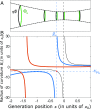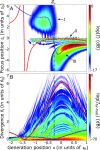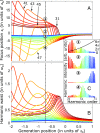Spatiotemporal coupling of attosecond pulses
- PMID: 30824594
- PMCID: PMC6421433
- DOI: 10.1073/pnas.1817626116
Spatiotemporal coupling of attosecond pulses
Abstract
The shortest light pulses produced to date are of the order of a few tens of attoseconds, with central frequencies in the extreme UV range and bandwidths exceeding tens of electronvolts. They are often produced as a train of pulses separated by half the driving laser period, leading in the frequency domain to a spectrum of high, odd-order harmonics. As light pulses become shorter and more spectrally wide, the widely used approximation consisting of writing the optical waveform as a product of temporal and spatial amplitudes does not apply anymore. Here, we investigate the interplay of temporal and spatial properties of attosecond pulses. We show that the divergence and focus position of the generated harmonics often strongly depend on their frequency, leading to strong chromatic aberrations of the broadband attosecond pulses. Our argument uses a simple analytical model based on Gaussian optics, numerical propagation calculations, and experimental harmonic divergence measurements. This effect needs to be considered for future applications requiring high-quality focusing while retaining the broadband/ultrashort characteristics of the radiation.
Keywords: Gaussian optics; attosecond pulse; focusing of XUV radiation; high-order harmonic generation; spatiotemporal coupling.
Copyright © 2019 the Author(s). Published by PNAS.
Conflict of interest statement
The authors declare no conflict of interest.
Figures








References
-
- Akturk S, Gu X, Bowlan P, Trebino R. Spatio-temporal couplings in ultrashort laser pulses. J Opt. 2010;12:093001–093020.
-
- Miranda M, et al. Spatiotemporal characterization of ultrashort laser pulses using spatially resolved Fourier transform spectrometry. Opt Lett. 2014;39:5142–5145. - PubMed
-
- Pariente G, Gallet V, Borot A, Gobert O, Quéré F. Space–time characterization of ultra-intense femtosecond laser beams. Nat Photon. 2016;10:547–553.
-
- Harth A, et al. Compact 200 kHz HHG source driven by a few-cycle OPCPA. J Opt. 2017;20:014007.
-
- Vincenti H, Quéré F. Attosecond lighthouses: How to use spatiotemporally coupled light fields to generate isolated attosecond pulses. Phys Rev Lett. 2012;108:113904. - PubMed
Publication types
LinkOut - more resources
Full Text Sources
Research Materials

